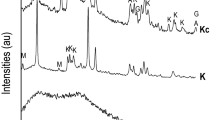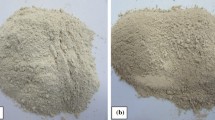Abstract
In the past decades, metakaolin additives synthesized by the calcination of kaolin clays have been implemented in cement systems. Their scarcity and high cost promotes the studies on the effectiveness of thermally activated additives of common polymineral clays. This article presents the results of research on the effect of thermally activated heavy loam additives to Portland cement. It was shown that additives of 5–15% heavy loam calcined at certain temperatures in the range of 400—600°C and ground to a certain specific surface area of up to 250–500 m2/kg lead to a more significant increase in the strength, density, and water resistance of cement stone than corresponding metakaolin additives with the specific surface area of 1200 m2/kg.
Similar content being viewed by others
References
Ludwig, H.-M., CO2-arme Zemente für nachhaltige Betone, Proc. 19th Int. Baustofftagung “Ibausil,” Weimar, September 16–18, 2015, Fischer, H.B., Boden, C., and Neugebauer, M., Eds., Weimar: Finger-Institute, 2015, vol. 2, pp. 7–32.
Ramachandran, V.S., Concrete Admixtures Handbook. Properties, Science and Technology, Amsterdam: Elsevier, 1999.
Rakhimov, R.Z. and Rakhimova, N.R., Construction and building materials of the past, present and future, Stroit. Mater., 2013, no. 1, pp. 124–128.
Afanas’eva, N.I., The current state of the mineral resource base of pozzolanic additives for the production of cement, Tsem. Ego Primen., 2015, no. 2, pp. 32–34.
Castello, L.R., Hernandes, H.J.F., Scrivener, K.L., and Antonic, M., Evolution of calcined clay soils as supplementary cementitious materials, Proc. XIII Int. Congr. on the Chemistry of Cement, Madrid: Inst. Ciencias Construcción, 2011, p.117.
He, C., Makovicky, E., and Osbaeck, S., Pozzolanic reactions of six principal clay minerals: Activation, reactivity assessments and technological effects, Cem. Concr. Res., 1995, vol. 25, p. 1961.
Thomas, M.D.A., Hopkins, D.S., Perreault, M., and Cail, K., Ternary cement in Canada, Concr. Int., 2007, vol. 29, no. 7, pp. 59–64.
Shehata, M.H. and Thomas, M.D.A., Use of ternary blends containing silica fume and fly ash to suppress expansion due to alkali-silica reaction in concrete, Cem. Concr. Res., 2002, vol. 32, no. 3, pp. 341–349.
Siddigye, R. and Klaus, I., Influence of metakaolin on the properties of mortar and concrete, Appl. Clay Sci., 2009, vol. 43, nos. 3–4, pp. 392–400.
De Weerdt, K., Kjellsen, K.O., Seellevold, E., and Justnes, H., Synergy between fly ash and limestone powder in ternary cements, Cem. Concr. Compos., 2011, vol. 33, pp. 30–38.
Nehdi, M., Ternary and quaternary cements for sustainable development, Concr. Int., 2001, vol. 24, no. 4, pp. 35–42.
Yermilova, E.Yu., Kamalova, Z.A., and Rakhimov, R.Z., Complex organomineral additive for blended portland cement, Inorg. Mater.: Appl. Res., 2016, vol. 7, no. 4, pp. 593–597.
Habert, G., Choupay, N., Escadeillas, G., Guillaume, D., and Montel, J.M., Clay content of argillites: Influence on cement based mortars, Appl. Clay Sci., 2009, no. 43, pp. 322–330.
Scrivener, K. and Favier, A., Calcined clays for sustainable concrete, 1st Int. Conf. on Calcined Glays for Sustainable Concrete, Losanna, 2015.
Rakhimov, R.Z., Rakhimova, N.R., and Gaifullin, A.R., Influence of the addition of dispersed fine polymineral calcined clays on the properties of Portland cement paste, Adv. Cem. Res., 2017, vol. 29, no. 1, pp. 21–32.
Roacha, J. and Klinowsry, J., Solid-state MMK students of the structure and reactivity of metakaolinite, Angew. Chem. Int., 1990, vol. 29, no. 5, pp. 553–554.
He, C., Makovicky, E., and Osbaeck, S., Thermal stability and pozzolanic activity of calcined illite, Appl. Clay Sci., 1994, vol. 9, pp. 165–187.
Caleman, N.I. and Mewhinnle, W.R., The soled state of metakaolin-blended ordinary Portland cement, J. Mater. Sci., 2000, vol. 35, no. 11, pp. 2701–2710.
Brykov, A.S., Metakaolins, Tsem. Ego Primen., 2012, nos. 7–8, pp. 36–41.
Gorbachev, B.Yu., Development of raw materials base of kaolin in the Russian Federation, Materialy mezhdunarodnoi nauchno-prakticheskoi konferentsii “Promyshlennye mineraly: problemy prognoza, otsenki i innovatsionnye tekhnologii osvoeniya mestorozhdeniya” (Proc. Int. Sci.-Pract. Conf. “Industrial Minerals: Forecasts, Exploration, Evaluation, and Advanced Technologies in Exploration of Field Deposits”), Kazan: Kazan. Izd. Dom, 2015, pp. 111–114.
Mehta, R.K., Studies of blended cement continuing Santorin Earth, Cem. Concr. Res., 1986, vol. 11, no. 4, pp. 507–512.
Pera, J., Ambrouse, J., and Messi, A., Pozzolanic activity of calcined laterite, Silic. Ind. Ceram. Sci. Technol., 1998, vol. 63, nos. 7–8, pp. 107–111.
Tikhonov, V.A., Shpynova, L.B., and Zdanovich, E.V., Getting a new local high-strength binder—glandular clay cement, Materialy soveshchaniya po issledovaniyu i ispol’zovaniyu glin (Proc. Meeting on Study and Use of Clays), Lvov: L’vovsk. Gos. Univ., 1957, pp. 36–41.
Ostnor, T., Jusfens, H., Martius-Hammer, T., and Danner, T., Calcined moral as alternative pozzolan, The 7th Central European Congr. on Concrete Engineering “Innovative Materials and Technologies for Concrete Structures,” Balatonfüred, 2011, pp. 151–154.
Fernandez, R., Vigil de la Villa, R., Gazsia, R., Rodriges, O., Fias, M., and Villas-Cocina, E., Characterization and pozzolanic activity of a calcined natural zeolite, Proc. XIII JCCE Int. Congr. on the Chemistry of Cement. July 3–8, 2011, Abstracts of Papers, Madrid, 2011, pp.100.
Guvalov, A.A. and Kuznetsova, T.V., Influence of volcanic ash of Dzheirangelsk deposit on properties of composite binders, Tekh. Tekhnol. Silik., 2013, vol. 20, no. 3, pp. 2–6.
Rakhimov, R.Z., Khaliullin, M.I., and Gaifullin, A.R., Composition and pozzolanic properties of claydite dust, Academia. Arkhit. Stroit., 2013, no. 4, pp. 112–116.
Taylor-Lange, S.C., Lamon, E.L., Riding, K.A., and Juenger, M.C.G., Calcined kaolinite-bentonite clay blends as supplementary cementations materials, Appl. Clay Sci., 2015, vol. 108, pp. 84–93.
Gard, N. and Skibsted, J., Pozzolanic reactivity of calcined interstratified illite/smectite (70/30) clay, Cem. Concr. Res., 2016, vol. 79, pp. 101–111.
Rakhimov, R.Z., Rakhimova, N.R., and Gaifullin, A.R., Effect of additives in Portland cement calcined and ground clay with 40% kaolinite on the strength of cement stone, Academia. Arkhit. Stroit., 2015, no. 2, pp. 129–131.
Gaifullin, A.R., Rakhimov, R.Z., and Rakhimova, N.R., The influence of clay additives in Portland cement on the compressive strength of the cement stone, Mag. Civ. Eng., 2015, no. 7, pp. 66–73.
Trümer, A. and Ludwig, H.-M., Special durability issues of concretes made with composite cements containing clays, Proc. 19th Int. Baustofftagung “Ibausil,” Weimar, September 16–18, 2015, Fischer, H.B., Boden, C., and Neugebauer, M., Eds., Weimar: Finger-Institute, 2015, pp. 627–634.
Lotenbach, B., Scrivener, K., and Hooton, R.D., Supplementary cementitious materials, Cem. Concr. Res., 2011, vol. 41, pp. 1244–1256.
Rakhimov, R.Z. and Rakhimova, N.R., Scientific, experimental, technical-economic and technological prerequisites for control of the structure and properties of filled artificial building composite materials, Gradostroitel’stvo, 2011, no. 4 (14), pp. 75–79; no. 5, pp. 100–103; no. 6, pp. 91–95.
Budnikov, P.P., Kolbasov, V.M., and Panteleev, A.S., Interaction of 3Ca·OAl2O3 and 4CaO·Al2O3Fe2O3 with calcium and magnesia carbonates, Dokl. Akad. Nauk SSSR, 1959, vol. 129, no. 5, pp. 1104–1106.
Kozlova, V.K., Manokha, A.M., Skakun, V.P., Malova, E.Yu., and Bozhok, E.V., The specific composition of hydration products of composite Portland cement with carbonate-containing additives, Tsem. Ego Primen., 2014, no. 4, pp. 102–105.
Author information
Authors and Affiliations
Corresponding author
Additional information
Original Russian Text © R.Z. Rakhimov, N.R. Rakhimova, A.R. Gayfullin, V.P. Morozov, 2017, published in Materialovedenie, 2017, No. 12, pp. 37–44.
Rights and permissions
About this article
Cite this article
Rakhimov, R.Z., Rakhimova, N.R., Gayfullin, A.R. et al. Effect of the Addition of Thermally Activated Heavy Loam to Portland Cement on the Properties of Cement Stone. Inorg. Mater. Appl. Res. 9, 679–686 (2018). https://doi.org/10.1134/S2075113318040330
Received:
Published:
Issue Date:
DOI: https://doi.org/10.1134/S2075113318040330




